Advertisements
Advertisements
प्रश्न
In order to supplement daily diet, a person wishes to take some X and some wishes Y tablets. The contents of iron, calcium and vitamins in X and Y (in milligrams per tablet) are given as below:
| Tablets | Iron | Calcium | Vitamin |
| X | 6 | 3 | 2 |
| Y | 2 | 3 | 4 |
The person needs atleast 18 milligrams of iron, 21 milligrams of calcium and 16 milligrams of vitamin. The price of each tablet of X and Y is Rs 2 and Rs 1 respectively. How many tablets of each should the person take in order to satisfy the above requirement at the minimum cost?
उत्तर
Let there be x units of tablet X and y units of tablet Y
So, according to the given information, we have
6x + 2y ≥ 18
⇒ 3x + y ≥ 9 ......(i)
| x | 0 | 3 |
| y | 9 | 0 |
3x + 3y ≥ 21
⇒ x + y ≥ 7 ......(ii)
| x | 0 | 3 |
| y | 9 | 0 |
2x + 4y ≥ 16
⇒ x + 2y ≥ 8 ......(iii)
| x | 0 | 8 |
| y | 4 | 0 |
x ≥ 0, y ≥ 0 ......(iv)
The price of each table of X type is ` 2 and that of y is ` 1.
So, the required LPP is
Minimise Z = 2x + y subject to the constraints
3x + y ≥ 9, x + y ≥ 7, x + 2y ≥ 8, x ≥ 0, y ≥ 0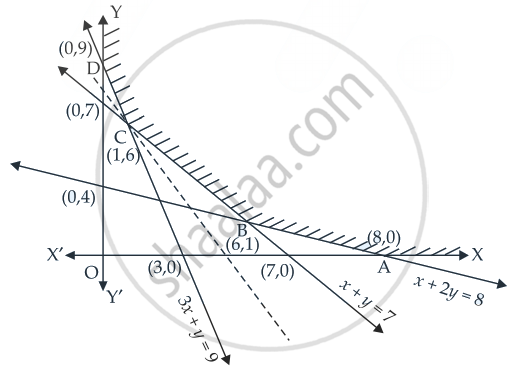
On solving (ii) and (iii) we get
x = 6 and y = 1
On solving (i) and (ii) we get
x = 1 and y = 6
From the graph, we see that the feasible region ABCD is unbounded whose corner points are A(8, 0), B(6, 1), C(1, 6) and D(0, 9).
Let us evaluate the value of Z
| Corner points | Value of Z = 2x + y | |
| A(8, 0) | Z = 2(8) + 0 = 16 | |
| B(6, 1) | Z = 2(6) + 1 = 13 | |
| C(1, 6) | Z = 2(1) + 6 = 8 | ← Minimum |
| D(0, 9) | Z = 2(0) + 9 = 9 |
Here, we see that 8 is the minimum value of Z at (1, 6) but the feasible region is unbounded.
So, 8 may or may not be the minimum value of Z.
To confirm it, we will draw a graph of inequality 2x + y < 8 and check if it has a common point.
We see from the graph that there is no common point on the line.
Hence, the minimum value of Z is 8 at (1, 6).
Tablet X = 1
Tablet Y = 6.
APPEARS IN
संबंधित प्रश्न
Show that the minimum of Z occurs at more than two points.
Minimise and Maximise Z = 5x + 10 y
subject to x + 2y ≤ 120, x + y ≥ 60, x – 2y ≥ 0, x, y ≥ 0.
Show that the minimum of Z occurs at more than two points.
Minimise and Maximise Z = x + 2y
subject to x + 2y ≥ 100, 2x – y ≤ 0, 2x + y ≤ 200; x, y ≥ 0.
A dietician wishes to mix together two kinds of food X and Y in such a way that the mixture contains at least 10 units of vitamin A, 12 units of vitamin B and 8 units of vitamin C. The vitamin content of one kg food is given below:
| Food | Vitamin A | Vitamin B | Vitamin C |
| X | 1 | 2 | 3 |
| Y | 2 | 2 | 1 |
One kg of food X costs Rs 16 and one kg of food Y costs Rs 20. Find the least cost of the mixture which will produce the required diet?
Determine the maximum value of Z = 11x + 7y subject to the constraints : 2x + y ≤ 6, x ≤ 2, x ≥ 0, y ≥ 0.
Maximise Z = 3x + 4y, subject to the constraints: x + y ≤ 1, x ≥ 0, y ≥ 0
Minimise Z = 13x – 15y subject to the constraints: x + y ≤ 7, 2x – 3y + 6 ≥ 0, x ≥ 0, y ≥ 0
Determine the maximum value of Z = 3x + 4y if the feasible region (shaded) for a LPP is shown in Figure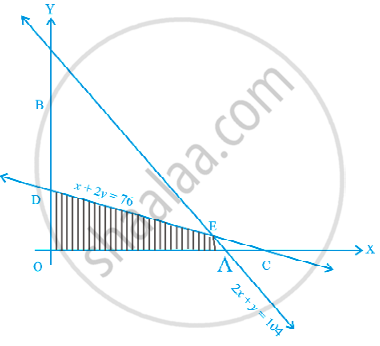
Feasible region (shaded) for a LPP is shown in Figure. Maximise Z = 5x + 7y.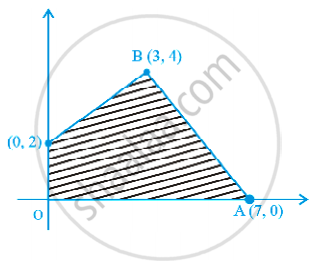
The feasible region for a LPP is shown in Figure. Find the minimum value of Z = 11x + 7y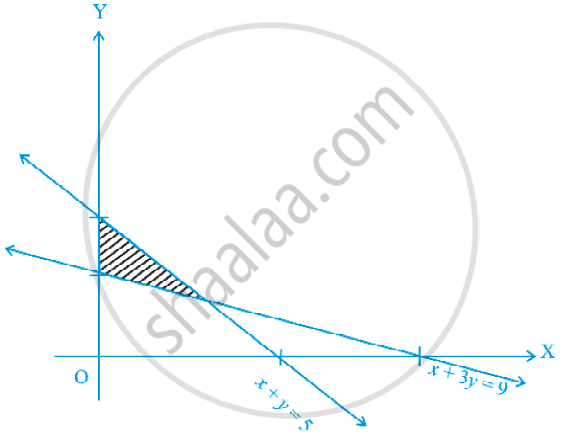
A man rides his motorcycle at the speed of 50 km/hour. He has to spend Rs 2 per km on petrol. If he rides it at a faster speed of 80 km/hour, the petrol cost increases to Rs 3 per km. He has atmost Rs 120 to spend on petrol and one hour’s time. He wishes to find the maximum distance that he can travel. Express this problem as a linear programming problem
Refer to quastion 12. What will be the minimum cost?
Refer to question 14. How many sweaters of each type should the company make in a day to get a maximum profit? What is the maximum profit.
Refer to Question 27. Maximum of Z occurs at ______.
The feasible region for an LPP is shown in the figure. Let F = 3x – 4y be the objective function. Maximum value of F is ______.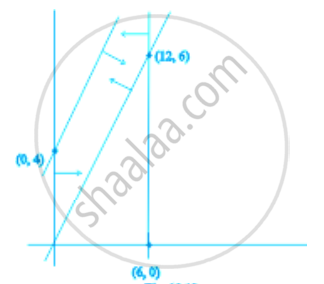
Refer to Question 32, Maximum of F – Minimum of F = ______.
If the feasible region for a LPP is ______ then the optimal value of the objective function Z = ax + by may or may not exist.
In a LPP if the objective function Z = ax + by has the same maximum value on two corner points of the feasible region, then every point on the line segment joining these two points give the same ______ value.
If the feasible region for a LPP is unbounded, maximum or minimum of the objective function Z = ax + by may or may not exist.
Maximum value of the objective function Z = ax + by in a LPP always occurs at only one corner point of the feasible region.
In a linear programming problem, the constraints on the decision variables x and y are x − 3y ≥ 0, y ≥ 0, 0 ≤ x ≤ 3. The feasible region:
Objective function of a linear programming problem is ____________.
In linear programming, optimal solution ____________.
If two corner points of the feasible region are both optimal solutions of the same type, i.e., both produce the same maximum or minimum.
Maximize Z = 7x + 11y, subject to 3x + 5y ≤ 26, 5x + 3y ≤ 30, x ≥ 0, y ≥ 0.
The feasible region for an LPP is shown shaded in the figure. Let Z = 3x - 4y be the objective function. Minimum of Z occurs at ____________.

